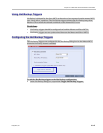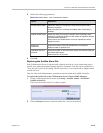
Chapter 21-Collaboration ServerAdministration and Utilities
Polycom, Inc. 21-45
• Recording Link
•
Profiles
•
IP Network Settings:
—
H.323 settings
—
SIP settings
—
DNS settings
—
Fix Ports (TCP, UDP) settings
—
QoS settings
Guidelines
• Both Master and Slave MCUs must have the same software version installed.
•
The Users list and Passwords must be the same on both the Master and Slave MCUs.
•
There must be connectivity between the Master and Slave MCUs, either on the same
network or on different networks connected through routers.
•
In the event of failure of the Master MCU the Slave MCU assumes the role of the Master
MCU. The Master/Slave relationship is reversed: the Slave, now active, remains the
Master and the previous Master MCU, when restarted, assumes the role of Slave MCU.
•
No changes to the Slave MCU are permitted while it is functioning as the Hot Backup.
Therefore no ongoing conferences or reservations can be added manually to the Slave
MCU.
•
If Hot Backup is disabled, all ongoing conferences and Reservations backed up on the
Slave MCU are automatically deleted.
•
In Hot Backup configuration, the SIP and H.323 Authentication configuration of the User
Name and Password in the IP Network Service Properties - Security tab of the Master
Collaboration Server are not backed up in the Slave Collaboration Server.
•
Master and Slave initial roles can be reversed only after all ongoing conferences and
Reservations are deleted.
•
Changes to the Master MCU that require a System Reset can only be made after Hot
Backup is disabled.
•
Video/Voice Port Configurations on the Master MCU are not synchronized with the Slave
MCU. You must manually set the Video/Voice Port Configurations on both the Master
and Slave MCUs to the same level.


















